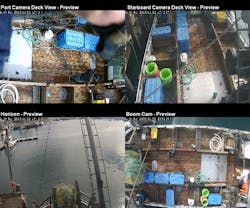Archipelago Marine Research deploys video surveillance solutions from VIVOTEK
For more than three decades, Archipelago Marine Research has helped fisheries, coastal communities, and industry regulators to implement sustainable practices through at–sea and dockside observer programs, electronic monitoring technology, and marine environmental services.
Archipelago’s fishery monitoring programs are optimized for each fishery, vessel, and gear type; employing human observers or automated alternatives as appropriate. As Western Canada’s largest and longest running observer–services company, Archipelago has led the development of video–based fishery monitoring alternatives for more than a decade; today, the company’s varied portfolio of fishery monitoring programs and services extends throughout North America, Europe, Asia Pacific, and beyond.
Archipelago also provides marine environmental services to help government, industry, and municipal groups balance the needs of seaside communities with the requirements of the marine environment. Services include coastal planning for commercial businesses, residential developments, and industrial work sites; surveys and assessment for near–shore and offshore development; and monitoring and evaluation of the marine environment—before, during, and after construction activities—to help minimize disruption to marine habitat.
Challenge
Besides monitoring fishing activity on commercial fishing vessels to ensure they stay within their catch limits and following fishing regulations, high seas poaching and piracy have also become a major concern. Deploying rugged and effective monitoring solutions in some extremely difficult scenarios such as on boat decks and rigging in extreme cold and violent weather as well as salt water nautical conditions has become challenging.
Solution
Archipelago came to VIVOTEK USA with the issues they were facing. As a result, Archipelago chose VIVOTEK’s FD9367-HV as it has weather-proof IP66-rated and vandal-proof IK10-rated housing, making it both sturdy and reliable, even in harsh marine environments.
Ultimately, 1,500 VIVOTEK cameras were chosen by Archipelago based on the camera’s overall cost and sea-worthiness to be used in its vessels worldwide. Some of the cameras chosen to be installed on Archipelago's vessels include the VIVOTEK FD9367-HV and FD9367-HTV.
The FD9367-HV is the new professional outdoor IR dome network camera from VIVOTEK, equipped with a full HD sensor capable of 1920x1080 resolution at 30 fps. With the most updated VIVOTEK SNV and WDR Pro technology, the FD9367-HV is capable of capturing the highest quality images in both low light and high contrast environments.
The FD9367-HV also offers a great image at night by equipping IR illuminators with an effective range up to 30 meters. With an IP66 and IK10 rated housing, the FD9367-HV is capable of operating under the harshest of conditions.
Additionally, the FD9367-HV employs VIVOTEK's Smart Stream III technology and H.265 compression codec, reducing bandwidth more than 90 percent while still maintaining excellent image quality compared to traditional H.264 without smart streaming. Furthermore, the VIVOTEK VADP (VIVOTEK Application Development Platform) allows users to add customized programs for various applications and user scenarios.
The FD9367-HV and FD9367-HTV are the ideal solutions for Archipelago's fishing vessels since they are made with encasings built to withstand working temperatures of between -4 degrees F to 122 degrees F. This ensures that cameras can continue to function normally, even in extreme cold conditions and violent weather typically experienced on boat decks.
Customer Feedback
“We chose the FD9367-HV and FD9367-HTV for a number of factors, and it has proven itself on our vessels as a reliable security solution,” said Mike Orcutt, Archipelago Field Services Manager. “Overall cost plus its sea-worthiness made it the best option for us and it is now being utilized on the high seas throughout the world.”
